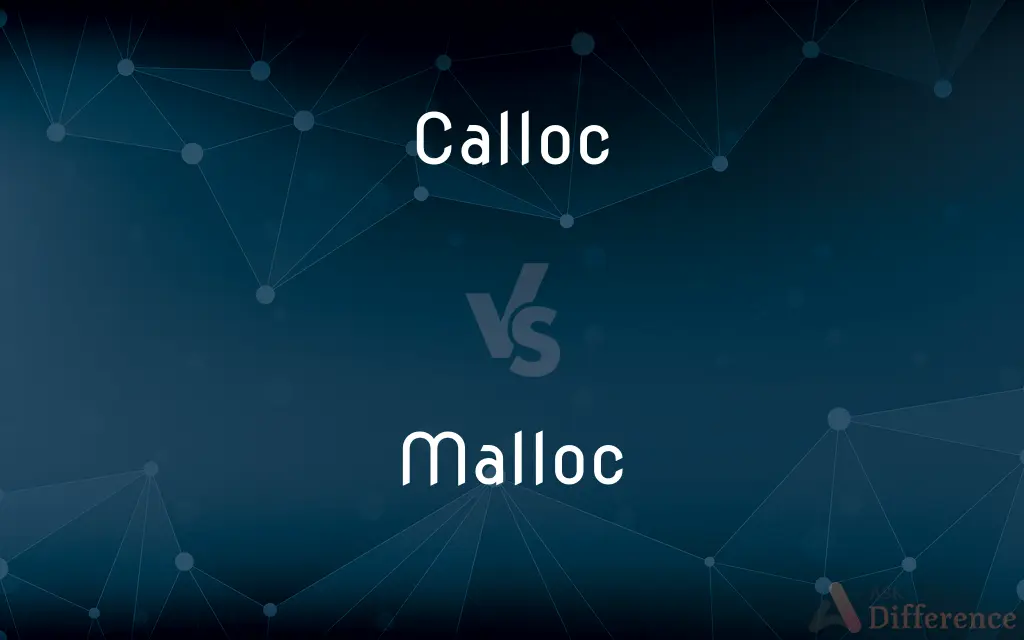Calloc vs. Malloc — What's the Difference?
By Tayyaba Rehman & Urooj Arif — Published on February 9, 2024
Calloc initializes allocated memory to zero and allocates memory in blocks, while Malloc does not initialize memory and allocates a single block.

Difference Between Calloc and Malloc
Table of Contents
ADVERTISEMENT
Key Differences
Calloc (Contiguous Allocation) and Malloc (Memory Allocation) are both used in C for dynamic memory allocation, but they serve slightly different purposes. Calloc allocates memory in contiguous blocks and initializes all bytes to zero, ensuring that all values are null and providing a level of security. Malloc, on the other hand, allocates a single block of memory without initializing it, which can lead to unpredictable values if not manually set.
While Malloc is efficient for allocating large, single blocks of memory, it may introduce vulnerabilities due to uninitialized data. Calloc, in contrast, might be slightly slower due to its initialization step, but it offers a safer memory allocation by ensuring all bits are set to zero. The choice between Calloc and Malloc often depends on the specific needs of the program and the importance of initialized memory.
Memory allocation size is also a distinguishing factor. Calloc requires two parameters (the number of elements and the size of each element) and multiplies these to determine the total memory to allocate. Malloc requires a single parameter that specifies the total memory in bytes. This difference in parameter requirements reflects their intended usage scenarios.
Error handling is another aspect where Calloc and Malloc differ. Both functions return a NULL pointer when memory allocation fails. However, due to Calloc's initialization process, some argue that it's easier to identify and handle memory allocation errors with Calloc compared to Malloc, where uninitialized memory might lead to more elusive bugs.
In conclusion, Calloc and Malloc are powerful tools for dynamic memory management in C programming. Calloc's initialization feature and block allocation approach make it suitable for scenarios where security and data integrity are paramount. Malloc's straightforward, single-block allocation is better suited for scenarios requiring raw performance and minimal overhead.
ADVERTISEMENT
Comparison Chart
Initialization
Initializes allocated memory to zero.
Does not initialize memory.
Memory Allocation
Allocates memory in contiguous blocks.
Allocates a single block of memory.
Parameters
Requires two parameters: number and size of elements.
Requires one parameter: the total memory size.
Performance
Slower due to initialization.
Faster, as there is no initialization.
Memory Overhead
Higher due to initialization and block management.
Lower, as it is a single continuous block.
Compare with Definitions
Calloc
Calloc allocates memory for an array and initializes it to zero.
Int* array = (int*)calloc(10, sizeof(int)); ensures all 10 integers are initialized to zero.
Malloc
Malloc is efficient for large, single memory allocations.
Char* buffer = (char*)malloc(1024); allocates 1024 bytes for a character buffer.
Calloc
Calloc is used when contiguous memory blocks and initialization are required.
Struct Node* nodes = (struct Node*)calloc(20, sizeof(struct Node)); for a zero-initialized node array.
Malloc
Malloc's single-parameter allocation is straightforward but requires manual initialization.
Struct Node* nodes = (struct Node*)malloc(20 * sizeof(struct Node)); allocates memory for 20 nodes.
Calloc
Calloc ensures memory safety by initializing all bits to zero.
Char* buffer = (char*)calloc(50, sizeof(char)); prevents garbage data in the buffer.
Malloc
Malloc allocates a block of memory without initializing it.
Int* array = (int*)malloc(10 * sizeof(int)); allocates memory for 10 integers.
Calloc
Calloc returns a void pointer to the allocated space, or NULL if the allocation fails.
Void* memory = calloc(5, 10); allocates and zeroes 50 bytes or returns NULL on failure.
Malloc
Malloc returns a void pointer to the allocated space, or NULL if the allocation fails.
Void* memory = malloc(50); allocates 50 bytes or returns NULL on failure.
Calloc
Calloc's two-parameter requirement allows precise memory allocation for arrays.
Double* matrix = (double*)calloc(100, sizeof(double)); allocates and zeroes a 100-element double array.
Malloc
Malloc provides raw memory without overhead, suitable for performance-critical applications.
Double* matrix = (double*)malloc(100 * sizeof(double)); allocates memory for a 100-element double array.
Malloc
(computing) A subroutine in the C programming language's standard library for performing dynamic memory allocation.
Malloc
(computing) To allocate memory using the C programming language malloc subroutine.
Common Curiosities
Which is faster, Calloc or Malloc?
Malloc is generally faster because it does not initialize the allocated memory.
How do Calloc and Malloc handle memory initialization?
Calloc initializes all allocated memory to zero. Malloc does not initialize the memory.
Can Calloc and Malloc return NULL?
Yes, both can return NULL if memory allocation fails.
Can the memory allocated by Malloc be resized?
Yes, using the realloc() function.
What happens if you allocate zero size with Calloc or Malloc?
Both return a unique pointer that can be successfully freed, but should not be dereferenced.
How does the performance of Calloc and Malloc compare when initializing memory is required?
If initialization is required, the performance difference may be negligible, as Malloc would require manual initialization.
What are Calloc and Malloc used for in C?
They are used for dynamic memory allocation. Calloc initializes memory to zero, while Malloc does not.
How do you free memory allocated by Calloc or Malloc?
Use the free() function for memory allocated by either Calloc or Malloc.
What parameters do Calloc and Malloc require?
Calloc requires the number and size of elements. Malloc requires the total size in bytes.
Are Calloc and Malloc interchangeable?
They can be used for similar purposes but have different behaviors (initialization and parameter requirements).
Which function is safer in terms of initialized memory?
Calloc is safer as it initializes memory to zero, preventing undefined behavior from uninitialized memory.
How does memory allocation failure manifest in Calloc and Malloc?
Both functions return a NULL pointer if the memory allocation fails.
Is it necessary to check the return value of Calloc and Malloc?
Yes, checking for a NULL pointer is essential to ensure that the memory allocation was successful.
Can you use Calloc and Malloc in C++ applications?
While possible, it's recommended to use C++ memory management techniques like new and delete.
What should be considered when choosing between Calloc and Malloc?
Consider initialization needs, performance requirements, and the specific structure of the data being allocated.
Share Your Discovery

Previous Comparison
White Eggplant vs. Purple Eggplant
Next Comparison
Rotten Tomatoes vs. IMDbAuthor Spotlight
Written by
Tayyaba RehmanTayyaba Rehman is a distinguished writer, currently serving as a primary contributor to askdifference.com. As a researcher in semantics and etymology, Tayyaba's passion for the complexity of languages and their distinctions has found a perfect home on the platform. Tayyaba delves into the intricacies of language, distinguishing between commonly confused words and phrases, thereby providing clarity for readers worldwide.
Co-written by
Urooj ArifUrooj is a skilled content writer at Ask Difference, known for her exceptional ability to simplify complex topics into engaging and informative content. With a passion for research and a flair for clear, concise writing, she consistently delivers articles that resonate with our diverse audience.
















































